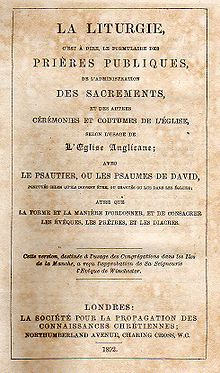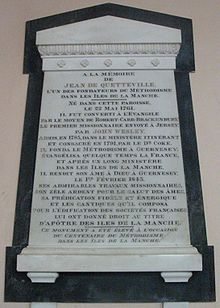- Religion in Jersey
-
 The wall paintings of the Chapelle ès Pêcheurs (Fishermen's Chapel) are a rare survival of the iconoclasm of the Reformation in Jersey.
The wall paintings of the Chapelle ès Pêcheurs (Fishermen's Chapel) are a rare survival of the iconoclasm of the Reformation in Jersey.
Religion in Jersey has a complex history and much diversity, considering the size of the island.
Jersey is a traditionally Christian island. The Church of England is the established church, but Methodism is traditionally strong in the countryside and there is a large Roman Catholic minority.
Contents
History
Before Christianity
In the Neolithic period religious activity in the settled communities is marked by the building of ritual burial sites known as dolmens, from which food and personal items such as jewelry, spindle whorls, pottery, tools and animal bones have been excavated at La Hougue Bie (a ritual site used around 3500 BC).[1] These finds indicate that Neolithic settlers possibly believed in an afterlife much like many modern religions, the burial of the dead with their belongings showing similarities to the burial process in the Egyptian religion. However recent excavations at La Hougue Bie by archaeologist Mark Patton, together with consideration of solar alignments, suggest that the Jersey Dolmens functioned more as centres of worship like cathedrals or churches, where burials are incidental to the main function.
Christianity
Celtic Christianity
There is some evidence from parish names of Celtic missions to the islands, notably Saint Brelade in Jersey and Saint Samson in Guernsey. Apart from place names and one note in the Life of Samson no documentary evidence is available.
Roman Catholicism
Main article: Roman Catholicism in Jersey The Hermitage of Saint Helier lies in the bay off Saint Helier, Jersey and is accessible on foot at low tide.
The Hermitage of Saint Helier lies in the bay off Saint Helier, Jersey and is accessible on foot at low tide.
Sometime between 535 and 545, Helier, who was to become Jersey's patron saint, went to the island bringing the gospel.[2]
The island of Jersey remained part of the Duchy of Normandy until 1204 when King Philip II Augustus of France conquered the duchy from King John of England. The islands remained in the personal possession of the king and were described as being a Peculiar of the Crown. However, the island continued to be part of the Norman diocese of Coutances and was reluctant to come under the wing of the English church because it had many cultural ties with Normandy.
The island embraced the French Calvinist form of Protestantism during the Reformation and orders were received to remove all signs of Catholicism in 1547.[3] In 1550 and 1551 church property was sold for the benefit of the crown. The island remained under the diocese of Coutances until 1569.
There were several waves of Roman Catholic immigration, notably in the 1790s during the French Revolution, in the 1830s and 1840s with the influx of Irish labourers and towards the end of the 19th century with the settlement of Catholic religious orders.
Protestantism
 The Book of Common Prayer was translated into French by Jerseyman Jean Durel, later Dean of Windsor, and published for use in the Channel Islands in 1663 as Anglicanism was established as the state religion after the Stuart Restoration.
The Book of Common Prayer was translated into French by Jerseyman Jean Durel, later Dean of Windsor, and published for use in the Channel Islands in 1663 as Anglicanism was established as the state religion after the Stuart Restoration.
French Calvinism
Islanders embraced Calvinism during the Reformation, especially under the influence of French language pamphlets and books from Geneva, France and the Low Countries.
The reign of Queen Mary was especially significant. Important Protestant religious leaders in Jersey and Guernsey fled to Geneva, and when they returned after Mary's death, they had taken on much of the severe form of Calvinism formulated there by Calvin, and set up Consistory Courts. Another factor was a reaction against the burning of heretics in the islands. In neighbouring Guernsey, Foxe records the remarkable death of the Protestant Perotine Massey, who gave birth while being burnt at the stake. Her newborn child was returned to the flames by the Catholic Bailiff.
There also was a sudden influx from France of Huguenots — the name given to French Calvinists — as Louis XIV revoked the Edict of Nantes in 1685, effectively depriving them of the freedom to practice their religion.[4].
The style of worship was resolutely Calvinist. Queen Elizabeth I left Jersey and Guernsey more or less in charge of their own affairs, because of political expedience: Protestant islanders would be in opposition to Catholic France.
Church of England
Although Jersey was transferred to the Diocese of Winchester in 1569, it was not until the Governorship of Sir John Peyton in 1603, under James I, that the forms of the Anglican church were restored to Jersey. In 1620 David Bandinel was appointed the first Dean of Jersey since the Reformation. Anglicanism then became and remained the official religion of the island.
Methodism
 Jean de Quetteville (1761-1843), a Saint Martinais, was converted by the first missionary sent to Jersey by John Wesley. This plaque, erected to commemorate the centenary of Methodism in the Channel Islands, describes him as the "apostle of the Channel Islands"
Jean de Quetteville (1761-1843), a Saint Martinais, was converted by the first missionary sent to Jersey by John Wesley. This plaque, erected to commemorate the centenary of Methodism in the Channel Islands, describes him as the "apostle of the Channel Islands"
In 1774 Pierre Le Sueur and Jean Tentin returned to Jersey from Newfoundland and started to preach Methodism to which they had been converted while engaged in the Newfoundland fisheries.[5] Some Huguenots were drawn to the ideas of Methodism similar to those of Calvinism.
Conflict with the authorities ensued when men refused to attend Militia drill when that coincided with chapel meetings. The Royal Court attempted to proscribe Methodist meetings, but King George III refused to countenance such interference with liberty of religion. The first Methodist minister in Jersey was appointed in 1783, and John Wesley preached in Jersey in August 1789, his words being interpreted into the vernacular for the benefit of those from the country parishes. The first building constructed specifically for Methodist worship was erected in Saint Ouen in 1809.
Religion in Jersey today
In addition to the Church of England (25 churches), the Roman Catholic Church (eight churches) and Methodism (sixteen churches), Jersey is host to the Abundant Life Church (one church), Baptists (one church), Plymouth Brethren (one assembly), Spiritual Christianity (one church), Pentecostalism (one church), the Greek Orthodox Church (one church), Jehovah's Witnesses (two churches), Latter-day Saints (one chapel), Evangelicalism (one church and an independent chapel), the Society of Friends (Quakers) (one meeting room), Presbyterianism (one church), the United Reformed Church (one church), members of the Bahá'í Faith, Judaism (one synagogue), Islam (one community centre) and various Pagans and Wiccans.
Islam
There are some 400 Muslims in Jersey who currently pray at Saint Thomas's Community Centre but are attempting to raise £500,000 for a mosque.[6]
Notable places of worship
- Parish Church of St Helier
- Fisherman's Chapel
- Grouville Church
- St Brelade's Church
- St Aubin on the Hill
References
- ^ Faith - Neolithic, Jersey Heritage Trust
- ^ Saint Helier - Saint Hélyi - Saint Hélier
- ^ The Image at Hougue Bie: Catholic Deceit or Protestant Propaganda
- ^ [1], Jersey Heritage Trust
- ^ Faith - Methodism, Jersey Heritage Trust
- ^ "islaminjersey.com". http://www.islaminjersey.com/. Retrieved 2006-08-28.
Print
- Balleine's History of Jersey, Marguerite Syvret and Joan Stevens (1998) ISBN 1-86077-065-7
- Jersey in Prehistory, Mark Patton, 1987
- The Channel Islands under Tudor Government, A.J. Eagleston
- Foxe's Book of Martyrs
- Reformation and Society in Guernsey, D.M. Ogier
- International Politics and the Establishment of Presbytarianism in the Channel Islands: The Coutances Connection, C.S.L. Davies
- Religion, History and G.R. Balleine: The Reformation in Jersey, by J. St John Nicolle, The Pilot
- The Reformation in Jersey: The Process of Change over Two centuries, J. St John Nicolle
- A Biographical Dictionary of Jersey, G.R. Balleine
- The Chroniques de Jersey in the light of contemporary documents, BSJ, AJ Eagleston
- The Portrait of Richard Mabon, BSJ, Joan Stevens
Online
External links
Religion in Europe Sovereign
states- Albania
- Andorra
- Armenia
- Austria
- Azerbaijan
- Belarus
- Belgium
- Bosnia and Herzegovina
- Bulgaria
- Croatia
- Cyprus
- Czech Republic
- Denmark
- Estonia
- Finland
- France
- Georgia
- Germany
- Greece
- Hungary
- Iceland
- Ireland
- Italy
- Kazakhstan
- Latvia
- Liechtenstein
- Lithuania
- Luxembourg
- Macedonia
- Malta
- Moldova
- Monaco
- Montenegro
- Netherlands
- Norway
- Poland
- Portugal
- Romania
- Russia
- San Marino
- Serbia
- Slovakia
- Slovenia
- Spain
- Sweden
- Switzerland
- Turkey
- Ukraine
- United Kingdom
- (England
- Northern Ireland
- Scotland
- Wales)
States with limited
recognition- Abkhazia
- Kosovo
- Nagorno-Karabakh
- Northern Cyprus
- South Ossetia
- Transnistria
Dependencies
and other territories- Åland
- Faroe Islands
- Gibraltar
- Guernsey
- Jan Mayen
- Jersey
- Isle of Man
- Svalbard
Other entities Categories:
Wikimedia Foundation. 2010.

